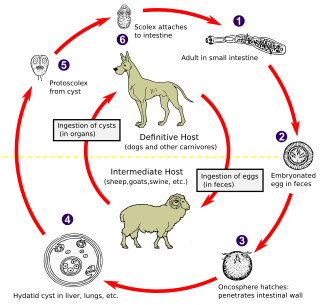
Echinococcosis is a parasitic disease of tapeworms of the Echinococcus type. The two main types of the disease are cystic echinococcosis and alveolar echinococcosis. Less common forms include polycystic echinococcosis and unicystic echinococcosis.
The Centrophoridae are a family of squaliform sharks. The family contains just two genera and about 15 species. They are sometimes called gulper sharks, but this is also the name of a specific species in the family, Centrophorus granulosus. These are generally deepwater fish. While some, such as the gulper shark C. granulosus, are found worldwide and fished commercially, others are uncommon and little-known. Their usual prey is other fish; some are known to feed on squid, octopus, and shrimp. Some species live on the bottom (benthic), while others are pelagic. They are ovoviviparous, with the female retaining the egg-cases in her body until they hatch.

Echinococcus granulosus, also called the hydatid worm, hyper tape-worm or dog tapeworm, is a cyclophyllid cestode that dwells in the small intestine of canids as an adult, but which has important intermediate hosts such as livestock and humans, where it causes cystic echinococcosis, also known as hydatid disease. The adult tapeworm ranges in length from 3 mm to 6 mm and has three proglottids ("segments") when intact—an immature proglottid, mature proglottid and a gravid proglottid. The average number of eggs per gravid proglottid is 823. Like all cyclophyllideans, E. granulosus has four suckers on its scolex ("head"), and E. granulosus also has a rostellum with hooks. Several strains of E. granulosus have been identified, and all but two are noted to be infective in humans.
Centrophorus is a genus of squaliform sharks. These deep-water sharks, found in temperate and tropical oceans throughout the world, are characterized by grey or brown bodies, large green eyes, and spines on both dorsal fins. These spines give them their name, from Greek κεντρον, kentron meaning "thorn" and φέρειν, pherein meaning "to bear".

The southern lanternshark is a shark of the family Etmopteridae found in the southeast Pacific between latitudes 29°S and 59°S, at depths of between 220 and 1,460 m. This species has been found off Northland, off the Chatham Islands, on the Campbell Plateau, all in New Zealand waters. Its length is up to 60 cm. Reproduction is ovoviviparous, with 10 to 13 pups in a litter, length at birth about 18 cm. They exhibit bioluminescence.
Rhinella humboldti is a species of toad in the family Bufonidae. It is found in Colombia, Venezuela, Trinidad, and the Guianas. This species was originally considered to be a subspecies of Rhinella granulosa.
Oreolalax granulosus is a species of amphibian in the family Megophryidae. Being restricted to the vicinity of its type locality in Jingdong County in southern Yunnan, where it occurs in Ailaoshan National Nature Reserve. It is endemic to China. Its natural habitats are subtropical moist montane forests and rivers. It is threatened by habitat loss.
Amolops granulosus is a species of frog in the family Ranidae that is endemic to China.

Synodontis granulosus is a species of upside-down catfish endemic to the Democratic Republic of the Congo, Burundi, Zambia, and Tanzania, where it is only known from Lake Tanganyika. It was first described by Belgian-British zoologist George Albert Boulenger in 1900, from specimens collected at multiple points along the shore of Lake Tanganyika. The species name comes from the Latin word "granulum", meaning of grain, and refers to the granular papillae present on the skin of the fish's body.

The granulated catfish is a species of thorny catfish found in the Paraná and Amazon basin as well as the coastal drainages of Suriname and Guyana. This species is commercially caught for human consumption as well as being displayed in public aquaria.
Rhodacaridae is a family of mites in the order Mesostigmata.
Protogamasellopsis is a genus of mites in the family Rhodacaridae.
Protogamasellopsis corticalis is a species of mite in the family Rhodacaridae.
Protogamasellopsis dioscorus is a species of mite in the family Rhodacaridae.
Protogamasellopsis posnaniensis is a species of mite in the family Rhodacaridae.

The granular pugolovka is a species of gobiid fish widespread in the Caspian Sea. It is a small fish, with a length up to 5.6 centimetres (2.2 in) TL. It was listed as Least Concern by the IUCN in 2008: there are no known major threats. Granular pugolovkas are very abundant in their habitat due to their size and lack of natural predators. The common name 'pugolovka' is a Ukrainian word for tadpole.

Epsiprantel is a veterinary drug which is used as an anthelmintic against tapeworms such as Echinococcus granulosus.
Pseudopolygnathus is an extinct genus of conodonts in the family Polygnathidae.
Aspergillus granulosus is a species of fungus in the genus Aspergillus. It is from the Usti section. The species was first described in 1944. It has been reported to produce asperugins, ustic acids, nidulol, and drimans.
Pandanus granulosus is a species of plant in the family Pandanaceae. It is native to the Bismarck Archipelago.






